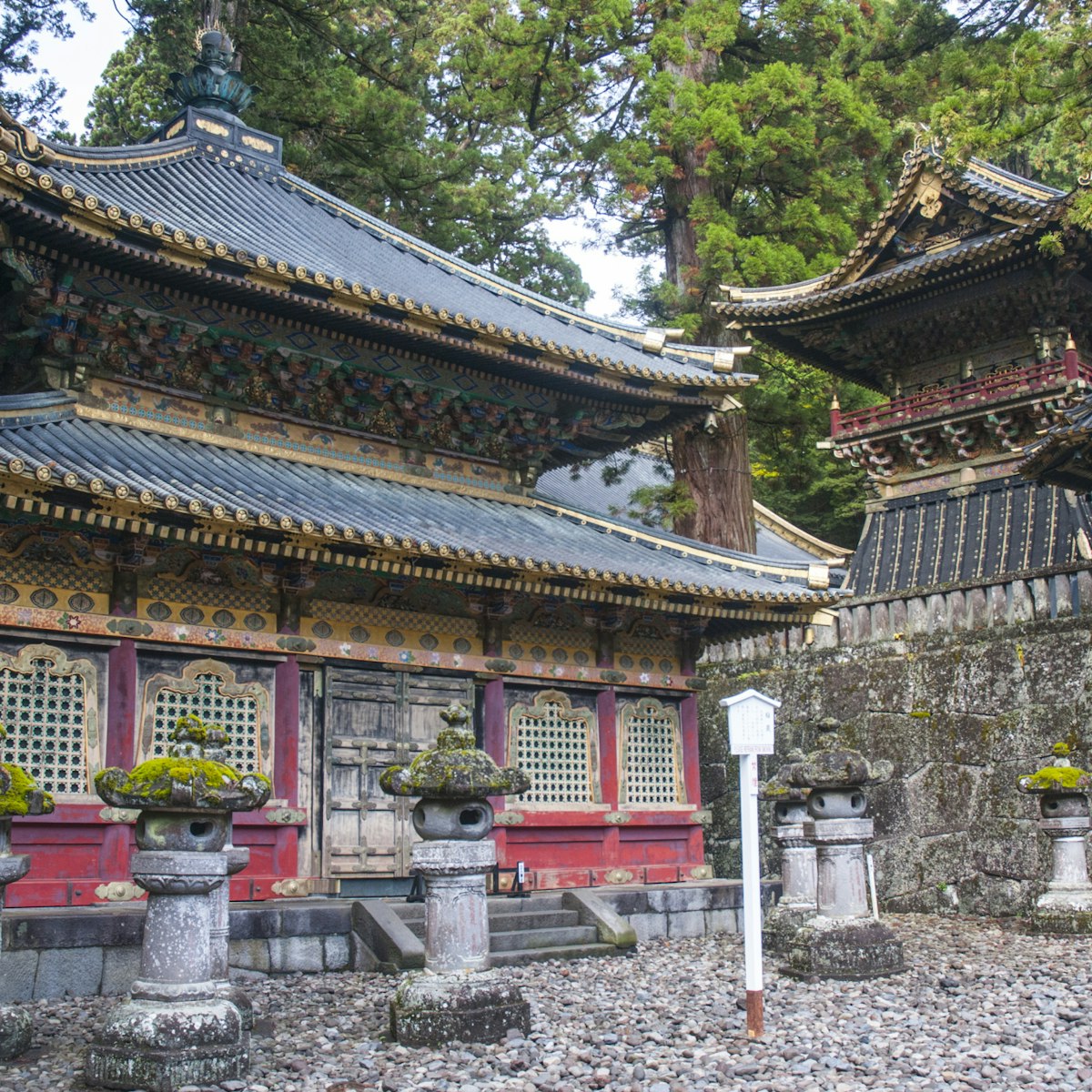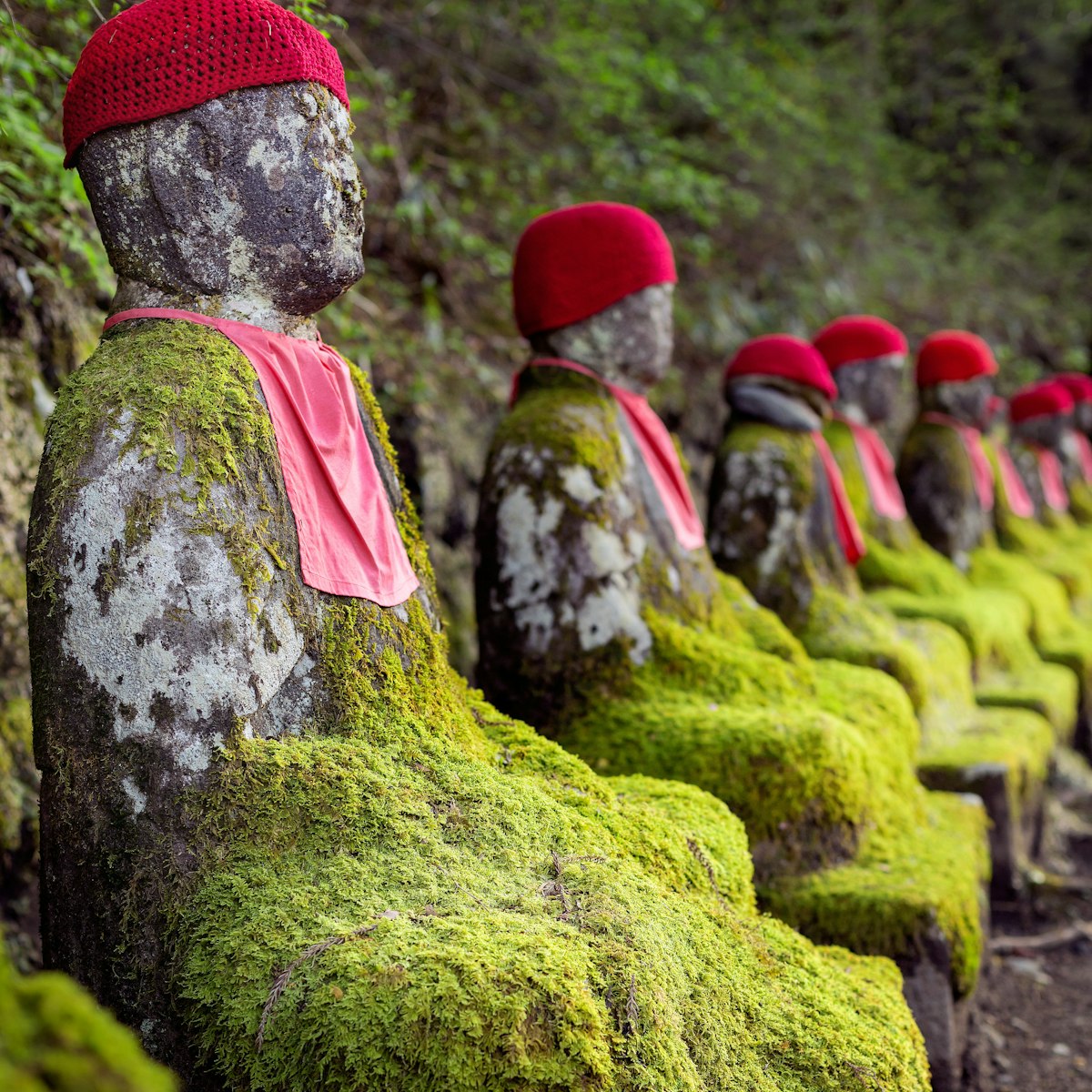
Tōshō-gū is Nikkō's biggest attraction, a shrine to the powerful shogun, Tokugawa Ieyasu (1543–1616). No expense was spared: when the original structure (completed in 1617) was deemed unsuitably grand, Ieyasu's grandson had it renovated two decades later, calling on the most celebrated artists of the day to work on the lavish structures, which are ornamented with gold leaf and black lacquer. It took 15,000 people to complete the project, at the modern equivalent of $100 million in manpower alone.
The compound was designed for maximum gravitas: visitors approach via a path lined with towering cedar trees, passing through a succession of ever more elaborate gates, decorated with carvings of mythical creatures like dragons, phoenixes and baku (a chimera who eats dreams). The shrine has been undergoing restoration work for over a decade, which was finally completed in 2019. As a result the structures are brilliant in colour, as they would have looked in the 17th century (when bold statement design was in vogue). The painstaking work was carried out using traditional materials (the white paint, for example, was made from powdered shells.
The first gate is Ishi-dorii, made of stone and dating to Tōshō-gū's original construction in 1619. To the left is 34.3m-tall Gōjūnotō, an 1819 reconstruction of the the five-storey pagoda first built in the mid-17th-century. The next gate is Omote-mon, guarded on either side by Deva kings.
In the outer courtyard are the Sanjinko, the 'Three Sacred Storehouses', built in the azekura-zukuri style of architecture (horizontally-stacked logs, often triangle-shaped). On the upper storey of the Kami-jinko (upper storehouse) are relief carvings of elephants by the highly-esteemed artist, Kanō Tan'yū, as he imagined them to look (having never seen the real thing).
Look to your right to see the Shinkyūsha, the 'Sacred Stable' and the only building of unpainted wood in the whole complex. It is crowned with relief carvings of the allegorical 'hear no evil, see no evil, speak no evil' monkeys, which demonstrate principles of Buddhist morality. They're also Nikkō's unofficial symbol. Just past it is the temizuya (font), with a Chinese-style gabled roof.
In the far left corner of the courtyard is the Honji-dō, which has a painting on its ceiling of the Nakiryū (Crying Dragon). Monks demonstrate the hall's acoustic properties by clapping two sticks together. The dragon 'roars' (a bit of a stretch) when the sticks are clapped beneath its mouth, but not elsewhere.
The next gate is Tōshō-gū's—and Japan's—most elaborately decorated one. Yōmei-mon, a National Treasure, has over 500 carved images depicting folk tales, mythical beasts and Chinese sages, restored to its original brilliant white and gold. Worrying that its perfection might arouse envy in the gods, those responsible for the gate's construction had the final supporting pillar installed upside down as a deliberate error.
A second gate, Kara-mon (唐門), also a National Treasure, leads to the shrine's inner courtyard. It's less ornate than the Yōmei-mon but considered more elegant and refined, in white, black and gold with lacquer inlay. The walls on the sides of both gates also have fantastic carvings, including peony arabesques. There are also many stone lanterns around the complex, which were gifted by loyal daimyō (feudal lords).
Gōhonsha, the main shrine, is built in the H-shaped gongen-zukuri style, with its Honden (本殿; Main Hall) and Haiden (拝殿; Hall of Worship) connected by a stone corridor. Inside these halls are paintings of the 36 immortal poets of Kyoto, and a ceiling-painting pattern from the Momoyama period; note the 100 dragons, each different. Fusuma (sliding door) paintings depict a kirin (a mythical beast that's part giraffe and part dragon).
On the right, near the entrance to the inner courtyard, is another gate, Sakashita-mon (坂下門), from where 207 stone steps lead to Okusha, the inner shrine, where Ieyasu is entombed. It's decorated not with dragons or phoenixes but with a sleeping cat, nemuri-neko. The diminutive carving is one of the most famous in Japan, attributed to the legendary (and possibly just a legend) artist Hidari Jingorō. Ieyasu is buried under a 5m-tall five-storey pagoda cast of gold, silver and bronze.
As Tōshō-gū is one of Japan's most famous attractions, it is routinely crowded, often with school groups and bus tours. Try to get here as early as possible.
 Publish for free
Publish for free

 zzdtravel
zzdtravel


















